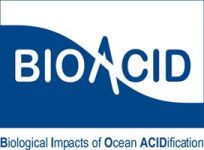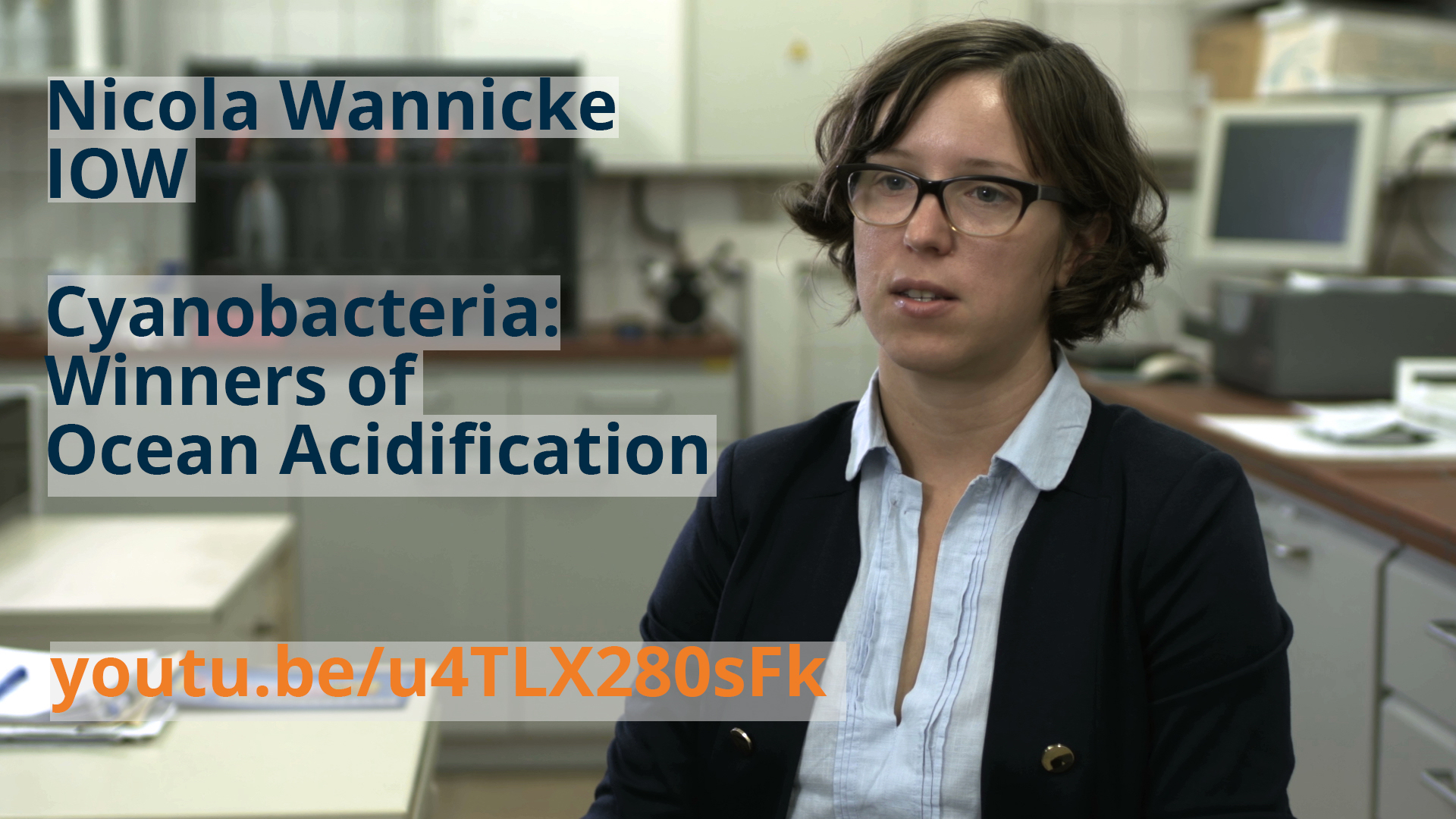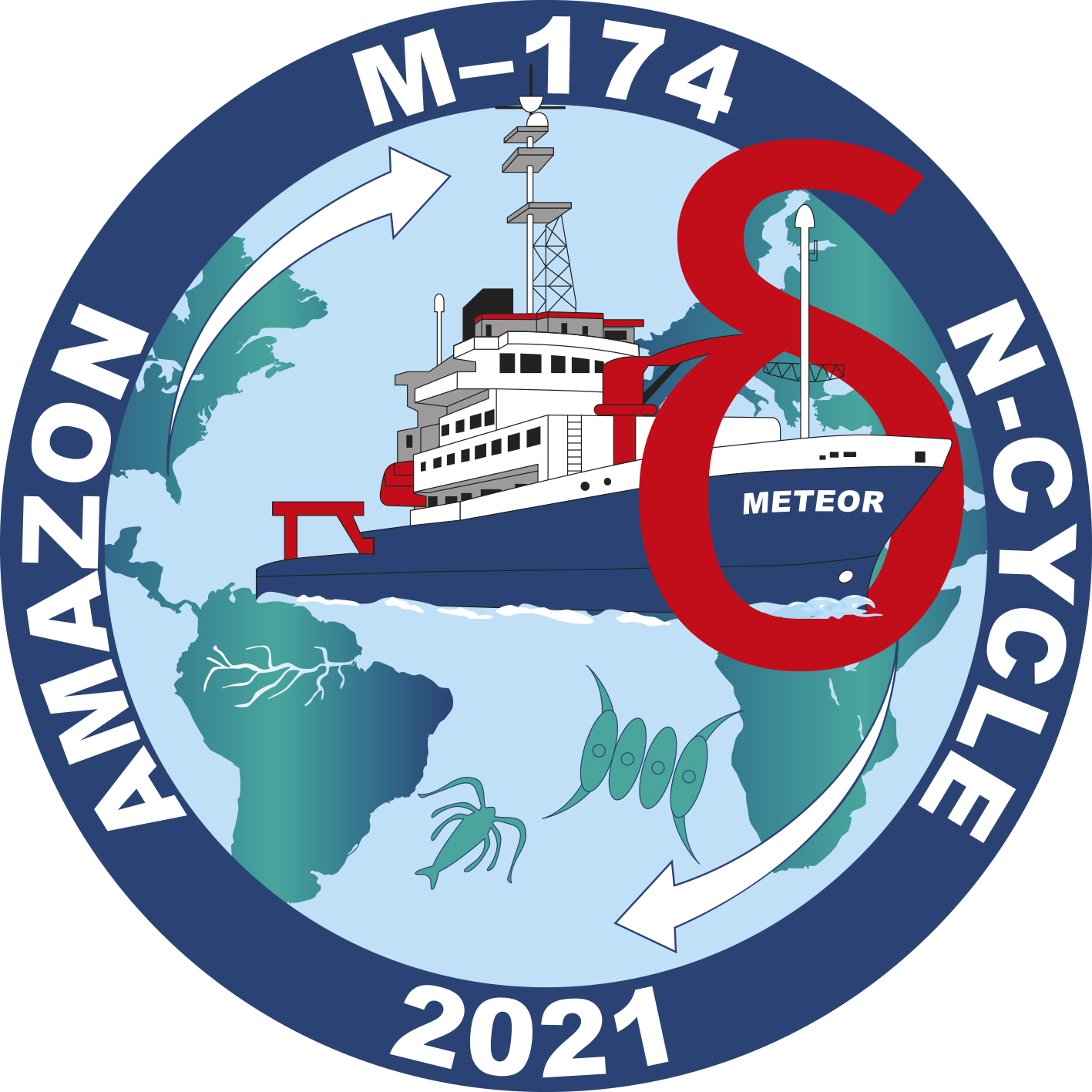
Finalised projects
AMBER - Assessment and Modelling Baltic Ecosystem Response
BIOACID - Biological Impact of Ocean Acidification
BluES - Blue_Estuaries - Developing estuaries as habitable sustainable ecosystem despite climate change and stress
COCOA -Nutrient COcktails in COAstal zones of the Baltic Sea
FONIP - Transfer of diazotrophic nitrogen into the pelagic food web: the role of essential and non-essential aminoacids
HYPER - HYPoxia mitigation for Baltic Sea Ecosystem Restoration
IAMM - Interactions among marine microbes as they grow and die: linking experiments and genome-scale models
NanoSIMS analysis of microbial driven nutrient turnover in the Baltic Sea ecosystem
N-Amazon: Forschungsfahrt METEOR M174 (GPF 19-1-13)
NiFiM - Stickstofffixierung in der monsunbeeinflussten Flussfahne des Mekong
NIQSI - Nitrate source identification and quantification in the euphotic zone of the Baltic Proper using nitrogen and oxygen stable isotopes (N Sources Baltic Proper)
NOTION: Nitrogen fixers structuring phytoplankton biodiversity in the ocean under climate change
N - Sinks Baltic - Quantification of Nitrogen sinks of the Baltic Sea and dependence on various environmental parameters
MeN-ARP : Metabolismus des Stickstoffs in der Amazonasfahne und dem westlichen, tropischen Nordatlantik (MeNARP)
MnION: M200 Expedition
SOPRAN - Surface Ocean Processes in the Anthropocene
TRACES - Ocean- Atmosphere- Land Impacts On Tropical Atlantic Ecosystems
Vietnam - project - Pelagic processes and nitrogen cycle in coastal waters off southern central Vietnam: mesocosm experiments, field work and modelling
Assessment and Modelling Baltic Ecosystem Response (AMBER )
(2009-2012)
The general aim of AMBER is the implementation and application of the Ecosystem Approach to Management (EAM) to the Baltic Sea with a focus on the coastal ecosystem (CE). The first step of AMBER is the separation of climate from anthropogenic signals in the CE by means of a combinatorial variation in model’s boundary conditions using the output of existing regional climate change scenarios and the output of a watershed model simulating changes in land use.
The second step of AMBER is the application of models for future projections. To reduce the problem of model uncertainties, the ensemble method will be applied. The resulting projections are milestones for the development of EAM tools.
To implement the EAM concept successfully requires the best available scientific information as a basis for integrated management. Therefore, retrospective analyses on long‐term data sets, intensive modeling with different types of models and selected measurements of biogeochemical transformation processes in the near coastal area and the groundwater will be applied and integrated into a sound scientific basis for supporting the development of EAM tools such as risk assessment, mitigation strategies, and Ecological Quality Objectives. Finally, cost‐effective indicators will be developed to improve monitoring strategies and to guide management decision making. EAM with its tools will be the core of science based advice for integrated management.
Contact: Dr. Maren Voß
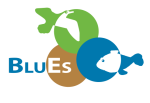
BluES - Blue_Estuaries - Developing estuaries as habitable sustainable ecosystem despite climate change and stress
BMBF (KüNO call) 11/2020-10/2023
A comprehensive study of the effects of stressors such as eutrophication, pollutant input, sediment shifting and heat waves on the biota of the two largest German estuaries Oder (Baltic Sea) and Elbe (North Sea) is being carried out by a group of scientists, representatives of authorities and nature conservationists. Both estuaries suffer from climate change and human activities, including dredging of fairways, which cause sediment loss, turbidity, and the release of nutrients and pollutants. The BluEs project will study the effects of stressors on food webs, and nutrient cycles through fieldwork, laboratory experiments and modeling.
At the IOW, functional diversity will be studied using the isotope of amino acids and in close coordination with the ecology of the fish and seabird species studied. The history and current eutrophication situation is reconstructed for the Oder and Elbe estuaries with sediment and nutrient data of the nitrogen isotopes. The control variables in the estuaries will be identified using network analyses combining as much data as possible from experiments and field studies to identify approaches for optimized management. The involvement of different stakeholders throughout the project will ensure the transfer of knowledge and scientifically based recommendations for sustainable development of estuarine systems.
Contact: Dr. Maren Voß
Nutrient COcktails in COAstal zones of the Baltic Sea
WP 2 - Microbial transformation processes
(2013-2017)
The overall strategy of COCOA is to obtain detailed information on nutrient and organic matter cycling from a few well-selected and well-studied learning sites supplemented with new measurements. We will use this information to extrapolate to all coastal sites in order to assess the different management options for the coastal zone as well as the open Baltic Sea through an improved description of coastal nutrient retention. The learning sites have been chosen to represent four specific types of coastal ecosystems for the Baltic Sea (river-dominated estuaries, lagoons, embayments with restricted water exchange, and archipelagos). The learning sites have been selected because 1) they are believed to be representative of the given coastal type, 2) an extensive monitoring program is already in place and long-term monitoring data sets are available, 3) they have been studied previously and research data are available, and 4) field sampling can be carried out more frequently and at a lower cost, since the sites are close to partner institutions.
The work in COCOA is organised around seven scientific work packages (WP1-7) with links as shown in Fig. 3 and one WP for the management of the consortium (WP8). Details of the work to be carried out are given in the WP descriptions below.
The general flow of information between WPs in COCOA. Field-sampling WPs are in blue, modelling WPs are in orange and WP7 addresses the potential application of the results for managing coastal as well as open waters of the Baltic Sea.
Contakt: Dr. Maren Voß
FONIP
Transfer of diazotrophic nitrogen into the pelagic food web: the role of essential and non-essential amino acids
What is the quality of nitrogen from N2-fixation by cyanobacteria (diazotroph nitrogen) for the marine ecosystem once it has been transformed into bioavailable molecules like amino acids? The annual input of nitrogen by nitrogen fixation has been estimated to be 110 Tg for the global ocean (Gruber and Sarmiento 1997, Capone 2001). Depending on the pathway and bioavailable form by which diazotroph nitrogen enters the food web, it may facilitate autotrophic or hetreotrophic growth and thus cause a carbon export from the euphotic zone, or bacterial production and respiration in the euphotic zone (Fig. 1, Mulholland 2007). A compound specific isotope analysis (CSIA) allows to track the qualitative and quantitative „end-to-end“ transfer of 15N marked N2 into the amino acids of cyanobacteria and further into the essential and non-essential amino acids of their grazers by gaschromatography-combustion-isotope ratio mass spectrometry (GC-C-IRMS). 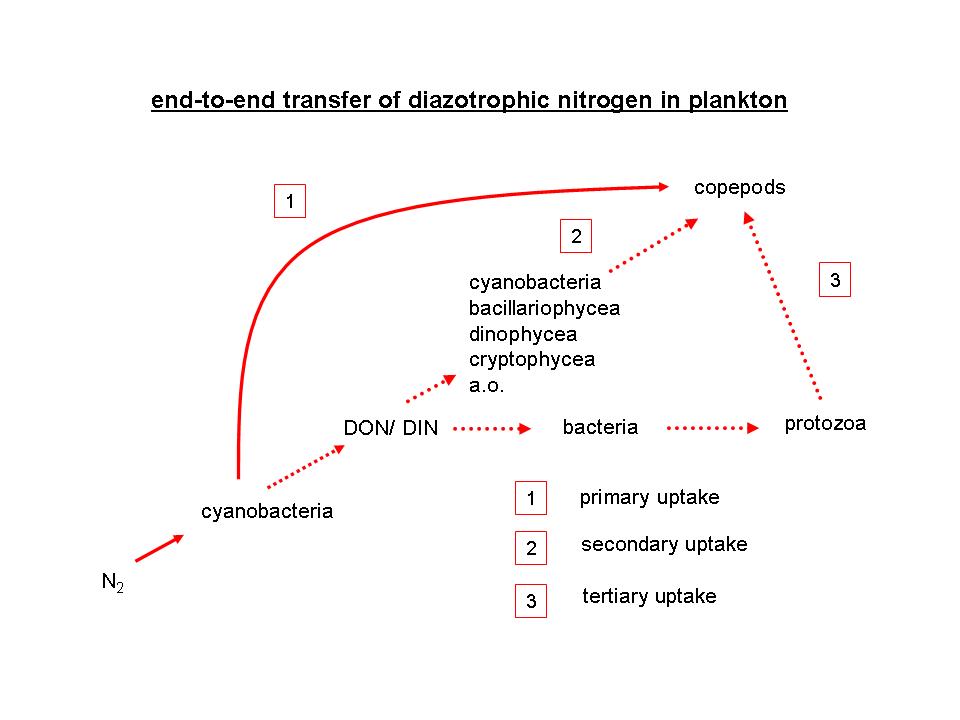
Fig. 1: Pathways of diazotrophic nitrogen into the heterotrophic food web. In the FONIP Project we investigate the primary uptake of diazotroph nitrogen by heterotrophs like copepods.
Besides field investigations we do controlled laboratory experiments with ecologically relevant model-organisms like the cyanobacterium Nodularia spumigena and its grazer the copepod Eurytemora affinis. For the first time we can quantify the transfer of newly formed amino acids from nitrogen fixation from the cyanobacteria into their grazers as well as detect the quality of the diazotrophic nitrogen for the zooplankton. The identification of the quality of diazotroph nitrogen as well as the quantification of its pathways into the marine ecosystem are fundamental prerequisites to predict the effects of increased or decreased diazotrophy in the context to global change like ocean acidification.
Literature
Capone, D. G., 2001. Current Opinion in Microbiology 4 (3): 341 – 348.
Gruber, N. and Sarmiento, J. L., 1997. Global Biogeochemical Cycles 11 (2): 235 – 266.
Mulholland, M. R., 2007. Biogeosciences, 4, 37–51.
HYPER
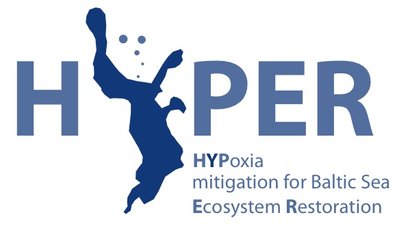
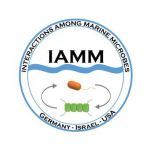
IAMM - Interactions among marine microbes as they grow and die: linking experiments and genome-scale models
(Human Frontier Science Program 2016-2019)
The oceans are teeming with microbial life, which impacts global biogeochemistry, climate and human health. Omics methods enable us to identify "who is there" and their genetic potential, but understanding how these organisms interact in nature and how they affect biogeochemical processes remains a major open challenge. A crucial component of this puzzle, at the heart of the cycling of nutrients in the biosphere, is the coupling between organisms that fix carbon using solar energy (phytoplankton) and microbes that rely on organic carbon for energy and growth (heterotrophs). The diversity of microbial species and the richness of their metabolism make the problem of predicting how each pair of species will interact impossible to address using traditional approaches. This project will tackle this challenge through a tightly integrated combination of genome scale modeling and laboratory experiments, to identify genomic traits dictating how environmentally-relevant microbes interact. Our approach, will provide a critical stepping-stone towards predicting how marine microbial systems will evolve in a changing world.
Contakt: Dr. Maren Voß, Dr. Angela Vogts
NanoSIMS analysis of microbial driven nutrient turnover in the Baltic Sea ecosystem
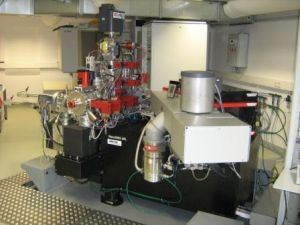
Since late 2011 a powerful instrument funded by the German Ministry for Science and Education is operated by the Leibniz-Institute for Baltic Sea Research Warnemünde (IOW). The project proposal was a cooperation of the IOW and the University of Rostock and the instrument is used by scientists of both institutions. NanoSIMS is the abbreviation for secondary ion mass spectrometer (SIMS) performing in the range of up to a few Nanometres (Nano). With this instrument up to seven isotopes and/or elements can be analysed and quantified in the subcellular level or in inorganic particles. Elemental compositions of such materials can be received with a lateral resolution of up to 50 Nanometres.
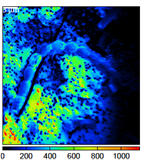
A well-established application is the single cell analysis of microorganisms. In this field isotope labelling experiments are of special interest. The uptake of isotopically labelled nutrients can be quantified on the single cell level by NanoSIMS analyses. Thus, e.g., C-, N- und S-nutrient cycling can be connected to the organisms performing this processes in lab cultures and natural habitats. From single cell results rates for larger areas like the redoxcline or the whole Baltic Sea can be extrapolated and the results can also be implemented in ecosystem modelling.
Contakt: Dr. Maren Voß, Dr. Angela Vogts
N-Amazon: Forschungsfahrt METEOR M174 (GPF 19-1-13)
The Amazon River is the largest river on earth and delivers 20% of global. Despite large seasonal variations in the outflow and inorganic nutrient concentrations, these impact the productivity along the northward spreading river plume and shape the phyto- and zooplankton communities. Higher tropic level organisms have to adapt to the varying food sources.
During the field program we will link direct measurements of hydrographic properties with focused experimental studies of nutrient supply and nutrient limitation of phytoplankton, as well as the transfer of phytoplankton nitrogen to the zooplankton food web. Species ecology will be evaluated by colleagues from Brazil. Isotopic evidence from particles and dissolved substances will be used to understand the processes and transport of material. Together the experimental and field data will allow delineating how heterotrophy and autotrophy can orchestrate the cycling of essential micro- and macronutrients in aquatic food webs.
Contact: Dr. Maren Voß
NiFiM - Stickstofffixierung in der monsunbeeinflussten Flussfahne des Mekong
(2016 - 2018)
The South China Sea (SCS) is the largest marginal sea in the world, surrounded by densley populated coastal states like China, Indonesia, Philippines or Vietnam. Climate change and strong anthropogenic impacts (18 major damming for hydropower are planned, aquaculture is increasing) in the catchment area of River Mekong will change riverine loads with the consequence of changes in near coastal biogeochemistry. The speed and magnitude of anthropogenic changes in the Mekong basin make it very likely that the proposed field program will be one of the few opportunities to study the SCS before significant changes in nutrient and organic matter loading occur as a result of anthropogenic impact in the river basin. The present role of the Mekong for the productivity of the SCS in comparison to upwelling nutrients will be studied. Previous results from us have suggested a strong role of diazotroph-diatom associations (DDA) in the river plume even in the presence of high nitrate concentrations, but also unicellular and colony forming cyanobacteria like Trichodesmium are present. Nutrient concentrations and nutrient ratios have been suggested to play a major role for the abundance and activity of the nitrogen fixing species and will be a focus of this study. Nutrient concentrations will be measured and the uptake of nitrogen and carbon will be quantified in field samples and specific incubation experiments. Bulk fixation rates of various N-fixing groups can be determined with isotope ratio mass spectrometry and on a cellular basis studied with NanoSIMS technology. Moreover, US and Vietnamese scientists will contribute important information on species composition and metabolic activity of nitrogen fixing communities. The outcome of this project will provide a solid understanding of the role of the Mekong river plume and upwelling processes on the N-fixing organisms in the coastal SCS. Future changes in river biogeochemistry can thus be evaluated on the basis of these results.
Two cruises to the SCS are financed by an approved proposal of Schmidt’s Oceanographic Institute. Field sampling and experimental work on board is thus secured. Moreover, previous DFG funding established close collaboration with the Institute of Oceanography in Nha Trang so that the proposed work builds upon an established Vietnamese-German collaboration.
Follow 3 members of our working group on a cruise to the South China Sea
A Changing River: Measuring Nutrient fluxes to the South China Sea - LEG1 (03.06.-17.06.2016)
Contakt: Dr. Maren Voß
NIQSI
Nitrate source identification and quantification in the euphotic zone of the Baltic Proper using nitrogen and oxygen stable isotopes (N Sources Baltic Proper)
Nitrate sources of the Baltic Proper will be identified and quantified by means of nitrogen and oxygen stable isotopes. The Baltic Sea is strongly influenced by the catchment (covering 4 times the area of the sea itself) and the anthropogenic activity there. In particular nitrate and phosphorus inputs via rivers, point sources, and atmospheric deposition cause eutrophication which aggravate anoxia in bottom waters. An additional source is nitrogen fixation by cyanobacteria in the euphotic zone. Potential nitrate sources are largely known. However, there are still substantial uncertainties regarding their quantity and relative importance for the primary production in the euphotic zone of the Baltic Proper. The denitrifier method, which enables measurement of both nitrogen and oxygen isotopes of nitrate, will be applied for the first time in this region. The isotope signature makes it possible to distinguish between different nitrogen sources and processes affecting the nitrate concentration in the euphotic layer. Potential sources (nitrate pool, atmospheric deposition plus for the first time dissolved organic nitrogen) will be analyzed. Additional experimental studies will help to determine the relative importance of different nitrogen forms (inorganic and organic) supporting the primary production. A nitrate budget for the euphotic layer in the central Baltic Sea will be established.
N sinks Baltic
"Quantification of Nitrogen sinks of the Baltic Sea and dependence on various environmental parameters" (N sinks Baltic), DFG funded (2007-2009)
The Baltic Sea is the largest brackish water body of the world and because of its enclosed position and the hydrographical conditions very sensible to nutrient inputs. Whereas the main sources of nitrogen are well known (nitrogen fixation and atmospheric deposition for the central Baltic; direct and riverine inputs for the coastal areas) there is still a lack of knowledge about the losses of reactive nitrogen via processes like denitrification and anaerobic ammonium oxidation (anammox; fig. 1). The microbial processes in the water column and the sediments are manifold and still less understood.
The DFG funded project "N sinks Baltic" deals with the quantification of these N losses. By means of the isotope pairing method the rates of denitrification and anammox are measured in different sediment types (mud, silt, sand) and the water column. The investigations are carried out at different seasons. Additional determinations of nutrient and oxygen profiles in the water column and the sediment as well as other sediment parameters should provide further information about the controlling factors.
By means of sediment maps the measured rates should be extrapolated to the whole area of the Baltic Sea.
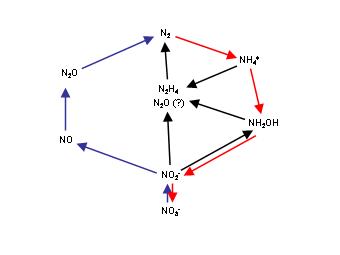
NOTION: Nitrogen fixers structuring phytoplankton biodiversity in the ocean under climate change

BNP Paribas (French Foundation) 04/2020-03/2023
The goal of NOTION is to determine how climate change will affect the activity of diazotrophs, and how they will impact phytoplankton biodiversity and productivity in the future ocean. To that end, we will enhance global ocean ecological models with new datasets and parameterizations stemmed from dedicated experiments. NOTION will take the unprecedented challenge of integrating genetic data into biogeochemical models to cover an important current gap in our knowledge: bridging phylogenetic and functional diversity. This new insight will be highly useful for the scientific community, serving as a role model for future studies focusing on other planktonic groups.
Contact: Dr. Maren Voß
Metabolismus des Stickstoffs in der Amazonasfahne und dem westlichen, tropischen Nordatlantik (MeNARP)
DFG 11/2020-10/2023
Estuaries critically control the export of allochthonous nutrients to the ocean. The Amazon River contributes nearly one fifth of the global riverine freshwater input to the ocean and the drainage basins is impact by human activities. The tremendous outflow of water and nutrients into the tropical Atlantic and Caribbean Sea has recently been linked to massive blooms of Sargassum in these areas. Light and different nitrogen (N) species control the production of photo- and heterotrophs (in the following trophic functional groups: TFGs) in the different habitats along the river plume. However, the role of allochthonous N for the production in different pelagic habitats along the plume is still unclear. Discordant lines of evidence suggest that all or none of the allochthonous N reaches the open ocean. We therefore want to quantify the N processes and the involved TFGs that can lead to retention of allochthonous N or to its export beyond these areas.
First, a detailed examination of the effects of allochthonous N considering food webs and nutrient biogeochemistry will be achieved for the different habitats. Based on dedicated experiments during the project`s cruise (M174) the understanding for complex relationships will be studied including the regulation of the planktonic food web structure. The ultimate goal is to generate a data based characterization of the habitats along the plume to improve estimations of carbon sequestration and N export. This will be achieved by translating the empirical data into feasible modeling instructions for biogeochemical models developed in close cooperation with partners of the project.
Contakt: Dr. Maren Voß
MnION - M200 Expedition
DFG - Deutsche Forschungsgemeinschaft (01.02.2024 - 01.09.2024)
During the expedition M200, a team of German and US scientists will conduct an examination of the link between manganese (Mn) cycling and other elemental redox cycles in the Baltic Sea’s oxygen-depleted basins. This work is linked to a cruise in summer 2020 on the R/VBorgese that first characterized the distribution and specia-tion of Mn throughout various basins within the Baltic Sea. On M200 we will investigate the biogeochemical processes driving turn-over of Mn at a subset of these stations, and will establish links between Mn redox cy-cling and other redox couples across the redoxcline. As the primary reactive Mn phases are predicted to exist within the sub-oxic zone, the focus will be on the links be-tween nitrogen (N), reactive oxygen species (ROS), and iodine (I). We will also explore links between Mn and the sulfur and carbon cycle across these zones. We will target microbial communities involved via cultur-ing approaches, and aim to understand the physical and geochemical controls regulat-ing these interactions. Starting from Rostock we will sample sta-tions in the Gotland Basin and the Landsort or Fårö Deeps. This cruise will focus on two sites, where we will conduct high resolution profiling of physical and geochemical redox structure and chemical speciation of select-ed elements, including water sampling for laboratory analyses. We will perform extensive shipboard incu-bations targeting rates of transformations, and enrich and culture microorganisms, e.g. phototrophic Mn oxidizing organisms, and microbes capable of coupling Mn redox changes to N and methane cycling. In paral-lel, water mass mixing on the measured ge-ochemical distributions will be studied. The overall goal is to achieve a mechanistic understanding of complex redox interac-tions in the Baltic redox transition zones, and comparable marine systems.
Contact: Dr. Maren Voß
Surface Ocean Processes in the Anthropocene

Surface Ocean Processes in the Anthropocene , BMBF funded (2007 - 2010)
Theme 2: Effect of Anthropocene CO2 levels on marine ecosystems and sea-to-air gas fluxes The atmosphere's composition determines the Earth's climate and habitability. This composition is, in turn, strongly determined by biological, physical and chemical processes occurring within the oceans. Increasingly, mankind is altering the composition of the atmosphere and therefore altering the interplay between the physical climate system and biogeochemistry. Such changes impact, in turn, the atmospheric composition, ocean ecosystems and climate via feedback processes. The SOPRAN (Surface Ocean Processes in the ANthropocene) project addresses three aspects of this interaction:
- How changing atmospheric composition (e.g. increased CO2, dust) affects the surface ocean ecosystem ?
- How climate-related changes in surface ocean processes (upwelling, mixing, light, biology) alter oceanic emissions to the atmosphere ?
- The mechanisms and rates of ocean-atmosphere material exchanges.
SOPRAN's focus is on processes operating within and close to the surface ocean, and their potential changes over the next century. The project is an integrated study of surface ocean response to global change, combining the insight of marine and atmospheric chemists, biological and physical oceanographers, as well as modelling on a range of scales. Shared activities include technological development and use of new floating mesocosms for studying global change effects on marine ecosystems, extension of physical modelling capabilities to study key biological and chemical processes in the surface layer, and the use of a new climate and biogeochemistry observatory in the Cape Verde Islands (in collaboration with UK, EU and Cape Verde investigators). The programme will deliver a better understanding of the role of the ocean in the climate system and an improved description of the effects of global change on the sensitive marine ecosystem. SOPRAN will furthermore:
The project involves 42 investigators from 12 partner institutions from all over Germany working in 23 sub-projects. The sub-projects are allocated to 4 inter-related Themes:
- the oceanic response to atmospheric dust
- effect of high CO2 on marine ecosystems and sea-toair gas fluxes
- production and emission of radiatively and chemically active gases in the Tropical Oceans
- inter-phase transfer at the sea surface.
These Themes are further interlinked by "Over-Arching Activities".Field work is concentrated in the Baltic Sea and the Eastern Tropical North Atlantic.
TRACES Ocean- Atmosphere- Land Impacts On Tropical Atlantic Ecosystems
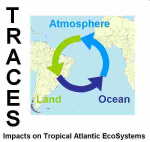
WGL-Network: "TRACES Ocean- Atmosphere- Land Impacts On Tropical Atlantic Ecosystems", funded by the Leibniz Institutes (2006-2008)
TRACES is a joint research project investigating interactions within the ecosystem Atlantic Ocean (an area that reacts critically towards global changes). Special focus is put on the exchange of matter (in particular carbon an nitrogen fluxes) between land, ocean and atmosphere within the tropical Atlantic Ocean. This region is of special importance for the global nitrogen balance, because here the commonly occurring nitrogen fixation is fuelled by the input of its limiting nutrients iron and phosphorous coming from terrestrial sources (dust and riverine input).
Aspects of the Tropical Atlantic Ocean network could focus on, or promote an exchange of ideas:
- theme 1: Carbon fluxes in Amazonia. Impact of climate variability and terestrial CO2 - emission on the carbon budget.
- theme 2: Transport and conversion processes in the atmosphere of the tropical Atlantic Ocean. Dust transport and climate Photochemistry of tropospheric aerosols and the barrier of the ozon layer
- theme 3: Abiotic influences on the ecosystem of the Atlantic Ocean.
Control of nitrogen fixation by external input of trace metals and macro nutrients
Transfer of recently fixed nitrogen within the food web
Vietnam project
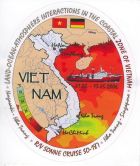
Pelagic processes and nitrogen cycle in coastal waters off southern central Vietnam: mesocosm experiments, field work and modelling" , DFG funded (2006 - 2008)
The DFG - project "Pelagic processes and biogeochemical fluxes in the South China Sea (SCS) off southern central Vietnam" is part of a German - Vietnamese Cooperation in Marine Science. The focus of our work is on the pelagic nitrogen cycle in the upwelling area off the Vietnamese coast. Seasonal changes in the relative importance of different N-nutrient sources for primary production (upwelling, input by Mekong-river, and biological fixation of atmospheric N2) and their impact on pelagic system dynamics are investigated. Since 2003 planktological and biogeochemical investigations were carried out jointly with our partner Institute of Oceanography Nha Trang (ION), the work of which is funded by Ministry of Science and Technology (MOST), Hanoi. We also work in close collaboration with the physical-oceanographic projects of University Hamburg (IfM) and of ION which elucidated hydrodynamics as the prime forcing of nutrient supply in our joint investigation area.
With a modified approach the project will be continued until 2008. Whereas field sampling on expeditions with large research vessels characterized the first project phase, emphasis is now on land-based mesocosm experiments in which upwelling and Mekong inflow will be simulated by mixing water from the different pelagic systems (Mekong plume, upwelling water, oligotrophic surface water). Our goal is to better understand pelagic production regimes typically encountered seasonally and regionally, regarding the contributions by different plankton (nitrogen fixing organisms and other functional groups), their response to upwelling and admixture of river water, and the impact of this on the overall nitrogen- and carbon cycles in the SCS. The experiments provide the opportunity to closely follow trends in primary production, uptake of different nitrogen species (NO3-, NH4+, N2), and succession as the plankton community responds to changing nutrient conditions. The mesocosm experiments are combined with ecosystem modelling of key processes in the N-cycle, results of which will be tested against field results and can be implemented in circulation models. Field studies using small ships in the Mekong river plume and the upwelling region will document in situ conditions of pelagic systems which provide the source material for the experiments and further link our work to partner projects.
We start the second phase of the project with the following hypotheses:
- The nutrient concentration and N/P ratios in the upwelling water drive the production and the species selection in the upwelling region off Vietnam.
- Mekong and other River water may act as additional driver of the production and of species selection through nutrient, silica, and DOM input
- A nitrogen cycle model can constrain the driving factors of productivity and species selection.
